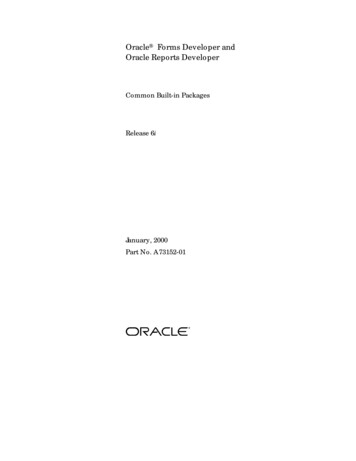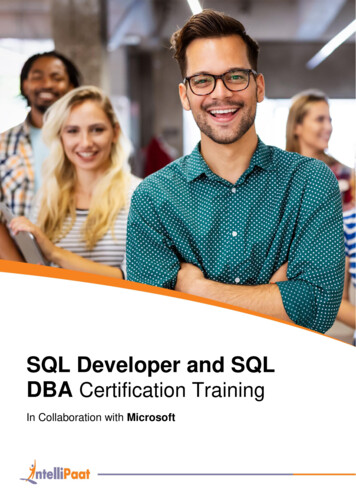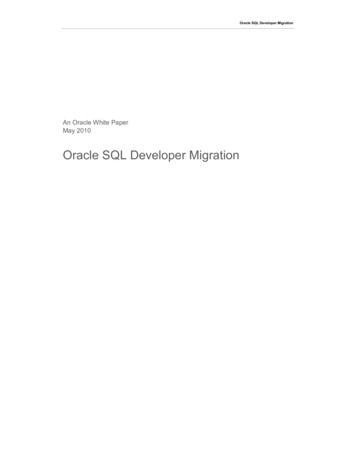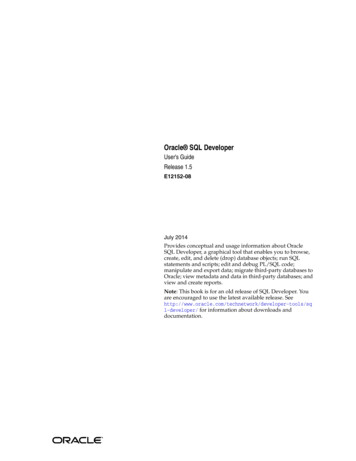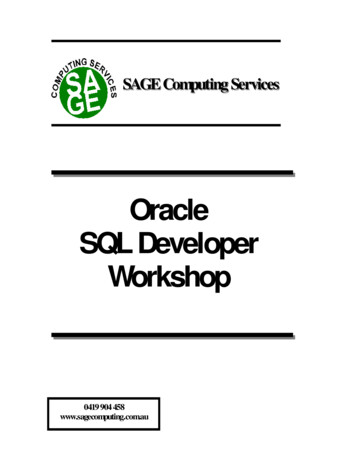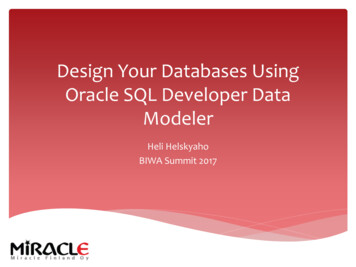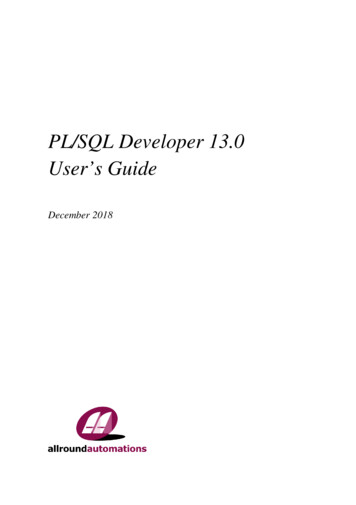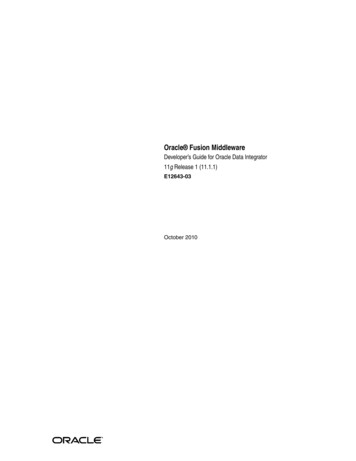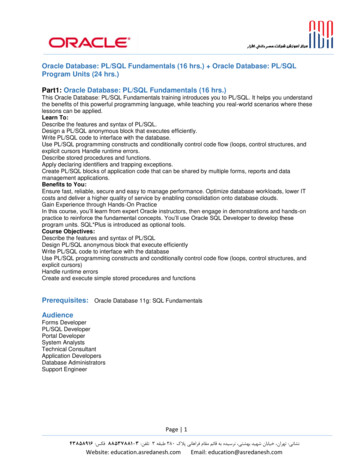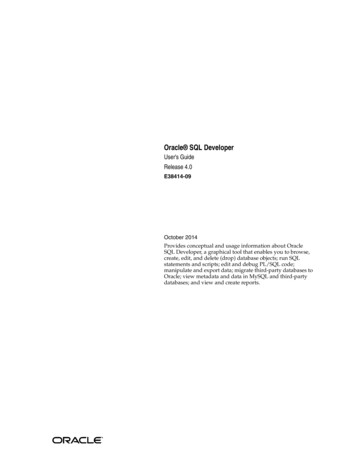
Transcription
[1]Oracle SQL DeveloperUser's GuideRelease 4.0E38414-09October 2014Provides conceptual and usage information about OracleSQL Developer, a graphical tool that enables you to browse,create, edit, and delete (drop) database objects; run SQLstatements and scripts; edit and debug PL/SQL code;manipulate and export data; migrate third-party databases toOracle; view metadata and data in MySQL and third-partydatabases; and view and create reports.
Oracle SQL Developer User's Guide, Release 4.0E38414-09Copyright 2006, 2014, Oracle and/or its affiliates. All rights reserved.Primary Author: Chuck MurrayThis software and related documentation are provided under a license agreement containing restrictions onuse and disclosure and are protected by intellectual property laws. Except as expressly permitted in yourlicense agreement or allowed by law, you may not use, copy, reproduce, translate, broadcast, modify, license,transmit, distribute, exhibit, perform, publish, or display any part, in any form, or by any means. Reverseengineering, disassembly, or decompilation of this software, unless required by law for interoperability, isprohibited.The information contained herein is subject to change without notice and is not warranted to be error-free. Ifyou find any errors, please report them to us in writing.If this is software or related documentation that is delivered to the U.S. Government or anyone licensing iton behalf of the U.S. Government, the following notice is applicable:U.S. GOVERNMENT END USERS: Oracle programs, including any operating system, integrated software,any programs installed on the hardware, and/or documentation, delivered to U.S. Government end usersare "commercial computer software" pursuant to the applicable Federal Acquisition Regulation andagency-specific supplemental regulations. As such, use, duplication, disclosure, modification, andadaptation of the programs, including any operating system, integrated software, any programs installed onthe hardware, and/or documentation, shall be subject to license terms and license restrictions applicable tothe programs. No other rights are granted to the U.S. Government.This software or hardware is developed for general use in a variety of information managementapplications. It is not developed or intended for use in any inherently dangerous applications, includingapplications that may create a risk of personal injury. If you use this software or hardware in dangerousapplications, then you shall be responsible to take all appropriate fail-safe, backup, redundancy, and othermeasures to ensure its safe use. Oracle Corporation and its affiliates disclaim any liability for any damagescaused by use of this software or hardware in dangerous applications.Oracle and Java are registered trademarks of Oracle and/or its affiliates. Other names may be trademarks oftheir respective owners.Intel and Intel Xeon are trademarks or registered trademarks of Intel Corporation. All SPARC trademarksare used under license and are trademarks or registered trademarks of SPARC International, Inc. AMD,Opteron, the AMD logo, and the AMD Opteron logo are trademarks or registered trademarks of AdvancedMicro Devices. UNIX is a registered trademark of The Open Group.This software or hardware and documentation may provide access to or information on content, products,and services from third parties. Oracle Corporation and its affiliates are not responsible for and expresslydisclaim all warranties of any kind with respect to third-party content, products, and services. OracleCorporation and its affiliates will not be responsible for any loss, costs, or damages incurred due to youraccess to or use of third-party content, products, or services.
ContentsPreface . xixAudience.Documentation Accessibility .Product Accessibility .Related Documents .Conventions .Third-Party License Information.1xixxixxixxixxxxxSQL Developer Concepts and 141.4.151.4.161.4.171.4.181.4.191.4.20About SQL Developer . 1-2Installing and Getting Started with SQL Developer. 1-2SQL Developer User Interface. 1-3Menus for SQL Developer. 1-7Restoring the Original "Look and Feel". 1-12Database Objects . 1-12Applications (Application Express 3.0.1 and Later) . 1-13Cache Groups (Oracle TimesTen In-Memory Database) . 1-14Chains . 1-14Credentials . 1-14Database Destinations. 1-14Database Links (Public and Private) . 1-14Destination Groups . 1-15Directories . 1-15Editions. 1-15File Watchers . 1-15Functions. 1-16Indexes. 1-16Java Sources . 1-17Jobs. 1-17Job Classes. 1-17Materialized Views. 1-17Materialized View Logs . 1-17Multitenant Container Database (CDB) . 1-18Packages . 1-18Procedures . 1-18iii
1.4.21Programs .1.4.22Queues.1.4.23Queue Tables .1.4.24Recycle Bin.1.4.25Replication Schemes (Oracle TimesTen In-Memory Database).1.4.26Schedules.1.4.27Sequences .1.4.28Synonyms (Public and Private) .1.4.29Tables.1.4.29.1Flashback Table Support .1.4.30Triggers .1.4.31Types.1.4.32Users (Other Users) .1.4.33Views .1.4.34Window Groups .1.4.35Windows .1.4.36XML DB Repository.1.4.37XML Schemas .1.4.38Captured and Converted Database Objects (for Migration) .1.5Database Connections .1.5.1Using Folders to Group Connections .1.5.2Sharing of Connections .1.5.3Advanced Security for JDBC Connection to the Database .1.5.4Connections with Operating System (OS) Authentication.1.5.5Connections with Proxy Authentication .1.5.6Connections with SSH Authentication .1.6Entering and Modifying Data .1.7Running and Debugging Functions and Procedures .1.7.1Using Bookmarks When Editing Functions and Procedures .1.7.2Remote Debugging .1.7.3Displaying SQL Trace (.trc) Files .1.7.4Using the PL/SQL Hierarchical Profiler .1.7.5Setting Expression Watches .1.8Using the SQL Worksheet.1.8.1SQL*Plus Statements Supported and Not Supported in SQL Worksheet.1.8.2Script Runner.1.8.3Execution Plan.1.8.4Autotrace Pane .1.8.5DBMS Output Pane .1.8.6OWA Output Pane .1.8.7SQL History .1.8.8Query Builder.1.8.9Command-Line Interface for SQL Formatting .1.8.10SQL Worksheet "Hints" for Formatting Output.1.8.11Gauges: In the SQL Worksheet and User-Defined Reports.1.8.12Entering OLAP DML Statements in the SQL Worksheet .1.9Using Snippets to Insert Code 401-411-421-421-421-431-431-441-441-441-451-461-47
1.9.1User-Defined Snippets .1.10Finding Database Objects .1.11Using Recent Objects .1.12Using Versioning .1.12.1About Subversion and SQL Developer .1.12.2About Perforce and SQL Developer .1.12.3About CVS and SQL Developer .1.12.4Pending Changes .1.13Using DBA Features in SQL Developer.1.13.1Container Database (CDB) .1.13.2Database Configuration .1.13.3Database Status .1.13.4Data Pump .1.13.5Performance.1.13.6RMAN Backup/Recovery .1.13.6.1Using Action Jobs .1.13.7Resource Manager .1.13.8SQL Translator FrameWork .1.13.9Scheduler.1.13.10Security.1.13.11Storage .1.14Scheduling Jobs Using SQL Developer.1.14.1Scheduler Design Editor .1.15Using the Cart.1.15.1Cart Versus Database Export Wizard .1.16Spatial Support in SQL Developer .1.16.1Context Menu Operations on Spatial Data and Metadata.1.16.2Map Visualization of Spatial Data.1.16.2.1Visualizing Geometries by Creating and Executing a Query .1.16.2.2Visualizing Geometries from the Table Data Grid .1.17Change Manager Support in SQL Developer .1.17.1Change Plan Administrators and Developers.1.17.2Developing Change Plans with SQL Developer .1.17.2.1Creating a Repository Connection .1.17.2.2Creating and Deleting Change Plans.1.17.2.3Adding and Updating Change Items .1.17.2.4Using Change Plans to Capture Change in SQL Developer .1.17.3Change Manager Actions to Perform with Enterprise Manager .1.17.3.1Creating Change Plans from Change Manager Schema Comparisons .1.17.3.2Deploying Change Plans .1.18Oracle REST Data Services Administration .1.18.1About Oracle REST Data Services .1.18.2Oracle REST Data Services Administration Toolbar and Context Menu .1.18.3Connecting to Oracle REST Data Services .1.18.4REST Data Services Navigator: Global and Database Settings .1.18.4.1Connections .1.18.4.2RESTful Connections (Database Settings only).1-471-48
[1]Oracle SQL Developer User's Guide Release 4.0 E38414-09 October 2014 Provides conceptual and usage information about Oracle SQ
